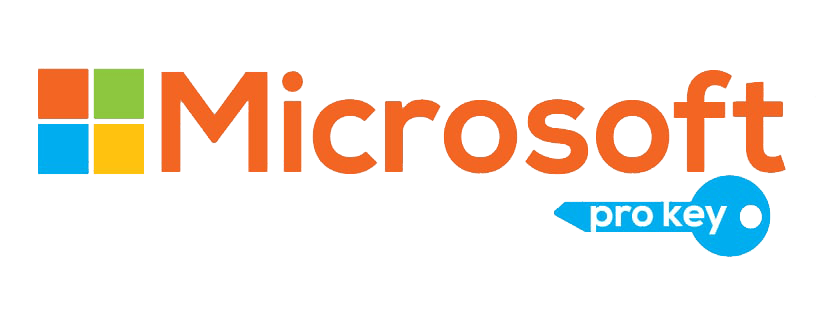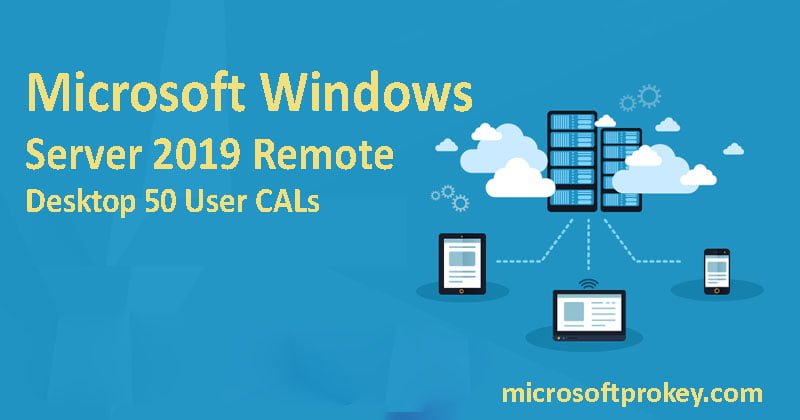Introduction of Microsoft Windows Server 2019 Remote Desktop 50 User CALs
Microsoft Windows Server 2019 Remote Desktop 50 User CALs key instant delivery (Client Access Licenses) are a licensing mechanism offered by Microsoft for organizations that want to use the Remote Desktop Services (RDS) feature in enter product key office 2019. RDS allows users to access applications and desktops running on a remote server from their client devices, enabling remote access and centralized management. The “50 User CALs” designation indicates that this particular license pack allows up to 50 individual users to connect to the Windows Server 2019 Remote Desktop Services concurrently. Each user who needs remote access through RDS would need an individual CAL.
It’s important to note that CALs are not software; they are licenses that give users or devices permission to access the server. Additionally, CALs are additive, meaning that if an organization already has existing CALs for Windows Server, the 50 User CALs can be added to increase the total number of concurrent remote connections allowed. When using Windows Server 2019 Remote Desktop with 50 User CALs key instant delivery, organizations can efficiently manage and provide remote access to a larger number of users while ensuring compliance with Microsoft’s licensing requirements.
What’s new features includes with Microsoft Windows Server 2019 Remote Desktop 50 User CALs?
I apologize for any confusion caused, but it’s important to clarify that the licensing mechanism itself, Microsoft Windows Server 2019 Remote Desktop 50 User CALs key instant delivery, does not introduce new features or functionality to the enter product key office 2019 Remote Desktop Services (RDS) itself. That said, Windows Server 2019 introduced several new features and improvements to the Remote Desktop Services (RDS) component. Here are some notable features and enhancements included in Windows Server 2019 Remote Desktop Services:
- Remote Desktop Protocol (RDP) 10: Windows Server 2019 includes an updated version of the Remote Desktop Protocol, providing improved performance, graphics, and security for remote connections.
- GPU virtualization: The server can leverage GPU hardware to enhance graphics performance for virtual desktops and applications.
- Improved security: Windows Defender Advanced Threat Protection (ATP) integration helps detect and respond to potential security threats. Role-based access control (RBAC) for RDS provides more granular control over permissions and access.
- Web client: The new HTML5-based web client allows users to access Remote Desktop Services using a web browser without the need for a separate Remote Desktop client application.
- Windows Admin Center integration: Windows Server 2019 includes integration with Windows Admin Center, providing a modern and unified management experience for RDS deployments.
- Disconnected session cleanup: RDS can automatically log off disconnected sessions to free up resources and improve overall system performance.
These are just a few examples of the features and improvements introduced in Windows Server 2019 Remote Desktop Services. It’s worth noting that Windows Server 2022, released after my knowledge cutoff date, may include additional enhancements and features.
Flexibility and Compatibility
Microsoft Windows Server 2019 Remote Desktop 50 User CALs key instant delivery offer flexibility and compatibility to organizations using the Remote Desktop Services (RDS) feature in Windows Server 2019. Here are some aspects related to flexibility and compatibility:
- User-based licensing: The 50 User CALs allow organizations to license a specific number of users (up to 50) rather than individual devices. This user-based licensing model provides flexibility for users to access RDS from multiple devices, such as desktop computers, laptops, tablets, or smartphones, without requiring additional CALs for each device.
- Concurrent connections: The User CALs enable up to 50 users to access RDS concurrently. This flexibility allows organizations to support a larger number of remote users accessing applications and desktops simultaneously, facilitating efficient remote work and collaboration.
- Compatibility with Windows Server 2019: The User CALs are specifically designed for Windows Server 2019, ensuring compatibility and compliance with Microsoft’s licensing requirements.
- Integration with Active Directory: Windows Server 2019 Remote Desktop 50 User CALs seamlessly integrate with Active Directory, allowing organizations to centrally manage and control user access to RDS.
- Compatibility with Remote Desktop Protocol (RDP): Windows Server 2019 Remote Desktop Services is compatible with the latest version of the Remote Desktop Protocol (RDP). This compatibility ensures that users can connect to RDS using a variety of client devices and operating systems that support RDP, including Windows, mac OS, Linux, and mobile platforms.
- Scalability and expansion: Organizations can easily add additional User CALs as needed to accommodate more users and scale their RDS deployment. This scalability provides flexibility for businesses that may experience growth or fluctuating user demands.
Overall, Microsoft Windows Server 2019 Remote Desktop 50 User CALs offer flexibility and compatibility, enabling organizations to efficiently manage user access, support remote work scenarios, and scale their RDS deployment as needed.
Comparison with others similar product
While Microsoft Windows Server 2019 Remote Desktop 50 User CALs key instant delivery provide licensing for enter product key office 2019 Remote Desktop Services (RDS), it’s worth comparing them to other similar products or licensing options available from Microsoft. Here are a few points of comparison:
- User CALs vs. Device CALs: Microsoft offers both User CALs and Device CALs for RDS licensing. User CALs allow a specific user to access RDS from any device, while Device CALs grant access to RDS for a specific device, regardless of the user.
- Different CAL quantities: Microsoft offers CAL packs in various quantities to cater to different organizational needs. In addition to the 50 User CALs, you can find CAL packs for smaller or larger user/device counts, such as 5, 10, 25, or higher.
- Enterprise Agreement (EA): Microsoft’s Enterprise Agreement is a volume licensing program that provides organizations with flexibility and cost savings for licensing various Microsoft products, including Windows Server.
- Remote Desktop Services Subscriber Access License (SAL): Apart from CALs, Microsoft also offers Remote Desktop Services Subscriber Access Licenses (SALs). SALs are suitable for service providers who offer RDS-based solutions to external users.
- Cloud-based alternatives: Microsoft also offers cloud-based solutions, such as Windows Virtual Desktop (WVD) on Azure. WVD is a virtual desktop infrastructure (VDI) solution that enables organizations to deploy and manage virtual desktops and applications in the cloud.
It’s essential to evaluate your organization’s specific requirements, user/device count, and deployment scenario to determine the most suitable licensing option.
Quick delivery product
Pay the price at the time of product order and your product will be delivered instantly by the email within few seconds
Smart Payment system
Order products and pay the price by Credit card, debit card, PayPal. Google pay, apple pay, crypto and receive your products instantly from the site microsoftprokey.com. Although there is no problem it getting the ordered product in case you do not get the ordered product correctly you will be refunded immediately or you can complain for the order.
System requirement
To clarify, Microsoft Windows Server 2019 Remote Desktop 50 User CALs do not have specific system requirements themselves. Here are the system requirements for Windows Server 2019 and the RDS feature:
Minimum System Requirements for Windows Server 2019:
– Processor: 1.4 GHz 64-bit processor or faster
– RAM: 512 MB (2 GB recommended)
– Hard Disk Space: 32 GB or more
– Network: Gigabit (10/100/1000baseT) Ethernet adapter
– Display: Super VGA (1024 x 768) or higher-resolution monito
For deploying the RDS feature in Windows Server 2019, you’ll also need to consider the system requirements specific to RDS. These requirements typically include:
– Active Directory Domain Services: A functioning Active Directory infrastructure is required for user and group management, authentication, and policy enforcement in RDS deployments.
– Remote Desktop Licensing: You need to set up a Remote Desktop Licensing (RD Licensing) server to manage the licensing for RDS CALs.
– Remote Desktop Session Host (RDSH): RDSH servers host the remote desktop sessions and applications for users. The system requirements for RDSH servers may vary depending on the number of users, applications, and workload.
– Remote Desktop Gateway (RD Gateway): RD Gateway provides secure remote access to RDS sessions over the internet. It requires appropriate network infrastructure and SSL certificates.
– Remote Desktop Web Access (RD Web Access): RD Web Access provides a web-based interface for users to access Remote Desktop resources. It requires IIS (Internet Information Services) and proper configuration.
– Remote Desktop Connection Broker (RD Connection Broker): RD Connection Broker is responsible for load balancing and connection redirection in multi-server RDS deployments. It requires proper network configuration and integration with Active Directory.
These are some of the key components and considerations for deploying Remote Desktop Services in Windows Server 2019.
Conclusion:
Investing in Microsoft Windows Server 2019 Remote Desktop 50 User CALs offers several benefits for businesses looking to manage their remote desktop infrastructure efficiently. With these CALs, organizations can enable up to 50 users to access the Windows Server 2019 Remote Desktop environment securely and seamlessly. These CALs provide the necessary licensing for users to connect to the server remotely, accessing applications, data, and resources as needed. Additionally, they ensure compliance with Microsoft’s licensing requirements, helping businesses avoid any legal issues related to software usage. Furthermore, by leveraging Windows Server 2019 Remote Desktop 50 User CALs, organizations can enhance productivity by enabling remote work capabilities for their workforce. This flexibility allows employees to access their work environment from anywhere, promoting collaboration and ensuring business continuity. The investment in Microsoft Windows Server 2019 Remote Desktop 50 User CALs is a strategic decision for businesses aiming to streamline remote access management, enhance productivity, and maintain compliance with licensing regulations.
FAQ:
Q-1. How many users can remote desktop into server 2019?
- Hello Microsoft Support team, after buying a Windows Server 2019 Remote Desktop Services license to enable multiple connections in our Windows Server 2019 server for multiple users. We know that without a license, only 2 simultaneous RDP connections are allowed.
Q-2. How many CALs do I need Windows Server 2019?
- Microsoft Windows Server 2019 Standard – 16 Core License + 10 CALs. *Microsoft requires a minimum of 16-cores per server and at least 8-cores per processor.
Q-3. What CALs are needed for Remote Desktop Services?
- RDS CAL is a license that you need to access a Remote Desktop on Windows Server. It is essential for Work-from-Home licensing and running desktop applications in the Cloud. It is also known as a “Terminal Services CAL”.
Q-4. Do you need user CALs for Server 2019?
- CALs are required by Microsoft licensing for all users or devices that access Windows Server Standard or Windows Server Datacenter.
Q-5. Do user CALs expire?
- The good news is that CAL’s do not expire, you only have to purchase new CAL’s if you upgrade your server.





